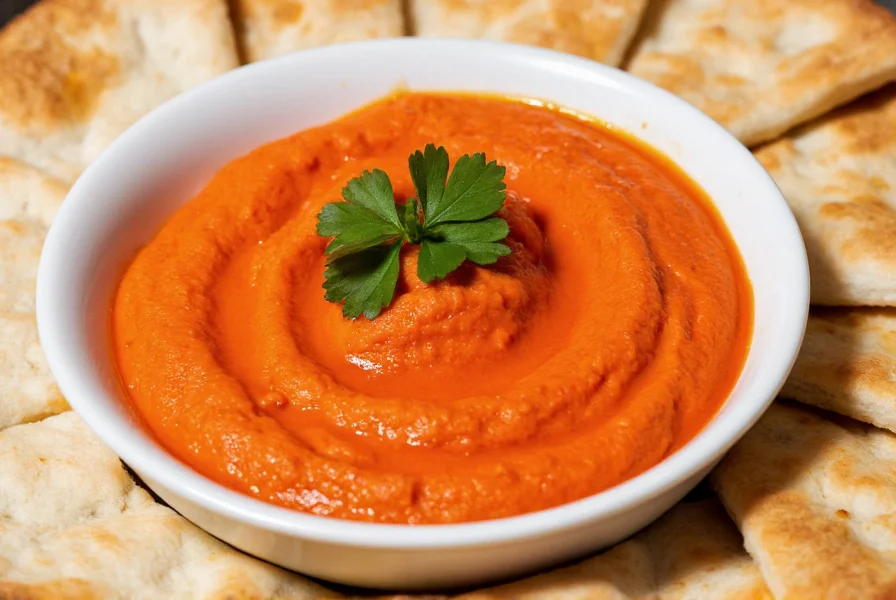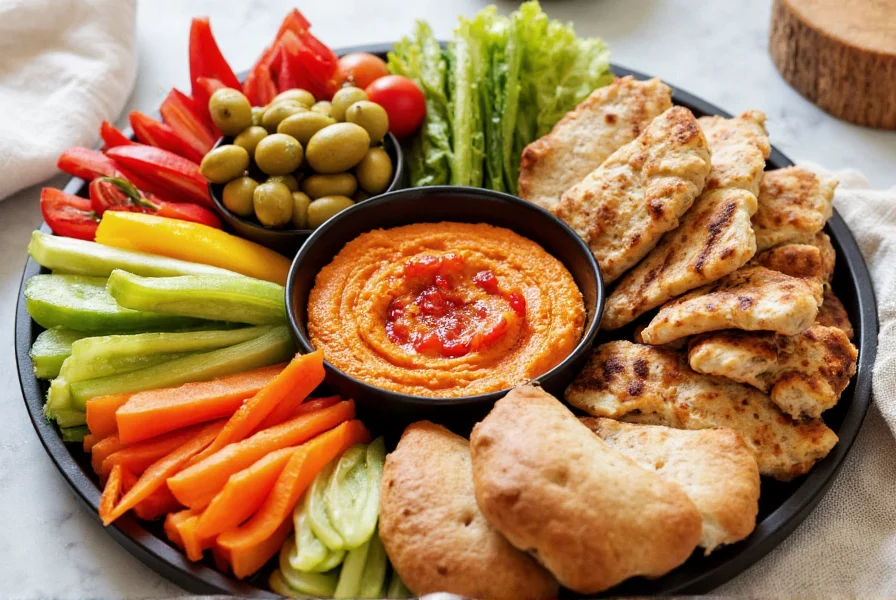Roasted red pepper hummus has become a beloved variation of the classic Middle Eastern dip, offering a vibrant twist that elevates both flavor and nutritional profile. This popular adaptation transforms the traditional chickpea spread with the sweet, smoky essence of roasted peppers, creating a visually striking and nutritionally enhanced dip perfect for modern entertaining and healthy eating.
The Evolution of Red Pepper Hummus
While traditional hummus dates back centuries in Middle Eastern cuisine, the red pepper variation emerged more recently as culinary traditions blended across cultures. Chefs and home cooks discovered that roasted red peppers complement the earthy chickpea base beautifully, adding both visual appeal and complex flavor dimensions. Unlike store-bought versions that often contain preservatives and artificial flavors, authentic roasted red pepper hummus relies on simple, high-quality ingredients prepared with care.
Nutritional Advantages of Red Pepper Hummus
The addition of roasted red peppers significantly enhances the nutritional profile of standard hummus. Bell peppers, particularly red varieties, contain three times more vitamin C than oranges by weight and are rich in carotenoids like lycopene and beta-carotene. When combined with the plant-based protein and fiber from chickpeas, this variation creates a nutritionally complete snack that supports heart health, boosts immunity, and provides sustained energy.
| Nutrient | Traditional Hummus (per 2oz) | Red Pepper Hummus (per 2oz) |
|---|---|---|
| Calories | 70 | 75 |
| Protein | 2g | 2g |
| Fiber | 2g | 2.5g |
| Vitamin C | 2% DV | 150% DV |
| Vitamin A | 0% DV | 45% DV |
Perfect Roasted Red Pepper Hummus Recipe
Creating exceptional red pepper hummus requires attention to ingredient quality and preparation technique. The following method produces restaurant-quality results with smooth texture and balanced flavor:
Ingredients for authentic roasted red pepper hummus
- 1½ cups cooked chickpeas (or one 15oz can, drained)
- 1 large red bell pepper, roasted and peeled
- ⅓ cup high-quality tahini
- 3 tablespoons fresh lemon juice
- 1½ tablespoons extra virgin olive oil, plus more for garnish
- 1 small garlic clove, minced
- ½ teaspoon ground cumin
- ½ teaspoon sea salt, or to taste
- 3-4 tablespoons ice water
- Optional: smoked paprika for garnish
Step-by-step preparation method
- Roast the red pepper over open flame or under broiler until completely blackened on all sides
- Place in covered bowl for 10 minutes, then remove skin and seeds
- Combine chickpeas, roasted pepper, tahini, lemon juice, olive oil, garlic, cumin, and salt in food processor
- Process for 2 minutes while gradually adding ice water until ultra-smooth
- Taste and adjust seasoning, adding more lemon for brightness if needed
- Transfer to serving bowl, create swirl pattern, and drizzle with olive oil

Professional Tips for Exceptional Texture and Flavor
Many home cooks struggle with achieving the perfectly smooth texture characteristic of high-end hummus. The secret lies in both ingredient preparation and blending technique. For optimal results when making roasted red pepper hummus at home:
- Peel chickpeas for ultra-smooth texture (gently rub cooked chickpeas between fingers to remove skins)
- Use ice-cold water during blending to maintain emulsion and prevent overheating
- Blend longer than you think necessary - at least 3-4 minutes for professional results
- Add lemon juice early in the process to help break down ingredients
- Let finished hummus rest for 2 hours before serving to allow flavors to meld
Creative Serving Suggestions for Red Pepper Hummus
While traditional pita chips remain popular, roasted red pepper hummus pairs beautifully with an array of creative accompaniments. Consider these serving ideas for your next gathering:
- As a vibrant base for Mediterranean grain bowls with quinoa, cucumber, and olives
- Spread on whole wheat wraps with grilled vegetables for a colorful lunch option
- As a sophisticated sandwich spread replacing mayonnaise in turkey or chicken wraps
- With vegetable crudités including endive, radishes, and heirloom carrots for visual appeal
- Swirled into warm lentil soup for added creaminess and flavor complexity

Storage and Shelf Life Guidelines
Proper storage maintains both safety and quality of homemade red pepper hummus. When stored in an airtight container in the refrigerator, freshly made hummus will remain at peak quality for 4-5 days. The vibrant red color may fade slightly over time, which is normal. For extended storage, freeze portions in ice cube trays then transfer to freezer bags for up to 3 months. Thaw overnight in the refrigerator and stir well before serving.
Avoiding Common Hummus Preparation Mistakes
Several pitfalls can compromise your roasted red pepper hummus results. Understanding these common errors helps ensure success:
- Using canned chickpeas without proper rinsing - residual starch creates gluey texture
- Skipping the roasting step for peppers - raw peppers create bitter, watery hummus
- Adding too much liquid - results in loose, unspreadable consistency
- Using old or rancid tahini - creates bitter aftertaste that dominates other flavors
- Over-processing garlic - releases harsh compounds that overpower delicate flavors
Frequently Asked Questions
Can I make roasted red pepper hummus without tahini?
Yes, you can substitute tahini with Greek yogurt or additional olive oil, though the flavor profile will differ significantly. For best results without tahini, use ¼ cup plain Greek yogurt and increase olive oil to 3 tablespoons. The hummus will be less traditional but still delicious with a brighter, tangier flavor profile.
Why is my red pepper hummus watery?
Watery hummus typically results from excess liquid in roasted peppers or over-processing. To fix watery hummus, drain peppers thoroughly after roasting, squeeze out excess moisture, and add 1-2 tablespoons of cooked chickpeas to absorb extra liquid. For future batches, reduce added water and ensure peppers are properly drained before blending.
How can I make my red pepper hummus smoother?
For ultra-smooth red pepper hummus, peel chickpeas before blending, use ice-cold water during processing, and blend for at least 3-4 minutes. Adding ½ teaspoon baking soda to cooking water when preparing dried chickpeas helps break down skins. Professional chefs often process hummus twice for maximum smoothness.
What's the best way to roast peppers for hummus?
The optimal method involves placing whole peppers directly over gas flame or under broiler, turning frequently until completely blackened. Transfer to covered bowl for 10 minutes, then remove skin and seeds. Avoid using roasted peppers from jars, as they contain excess liquid and preservatives that compromise texture and flavor in homemade hummus.
Can I use jarred roasted red peppers for hummus?
While convenient, jarred roasted peppers often contain excess vinegar and preservatives that alter flavor and texture. If using jarred peppers, drain thoroughly, rinse under cold water, and pat dry with paper towels to remove excess moisture. For best results, roast fresh peppers yourself to control the flavor profile and texture of your homemade red pepper hummus.











 浙公网安备
33010002000092号
浙公网安备
33010002000092号 浙B2-20120091-4
浙B2-20120091-4